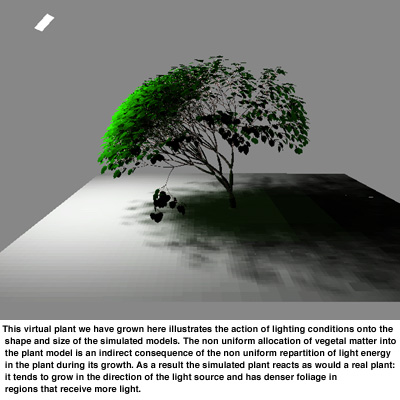
ERCIM News No.44 - January 2001 [contents]

![]()
ERCIM News No.44 - January 2001 [contents]
by François Sillion and Cyril Soler
The goal of the SOLEIL project is to simulate the ecophysiological processes in plants and to interactively compute their growth and productivity depending on external conditions, especially the presence of light. The lighting simulation in the plant models is performed by a new technique based on a combination of hierarchical radiosity and instanciation. This combination allows to perform accurate simulations in very large models, which was not possible before.
SOLEIL is a cooperative research project between INRIA, LIAMA - the French-Chinese Laboratory of Computer Graphics and Applied Mathematics, and CIRAD - the International Research Center for Agronomy and Development. The work carried out in the project can have major impact on at least two different fields: as it is simulates the physiological behaviour of plants, based on calibrated models of growth, it will permit to study the influence of environmental conditions on plant growth for various agronomic applications. it is also of interest for virtual reality systems, because the very realistic plant models it creates can be incorporated into any virtual reality systems such as architecture design programs or video games.

The physiological simulation of plant growth consists in growing virtual models of plants from the biological laws that rule plant internal functionality. A physiological simulator thus accounts for hydraulics inside the plant structure, mechanics that is responsible for the shape of the plant, and the amount of light received by the leaves. While the photosynthesis activity of each leaf indeed strongly depends on the local illumination, all previous plant growth models did not compute an accurate estimation of this quantity because of the extensive computation cost traditionally associated with lighting simulations that accounts for diffusion and shadowing inside the foliage. We have derived a new algorithm capable of performing efficient yet accurate lighting simulations in plants consisting of millions of polygons.
The method is based on the concept of instanciation, adapted to the traditional hierarchical radiosity methods for computing global illumination. Instanciation consists in replacing parts of the plant geometry that share common geometric or radiometric properties by references to shared objects during the simulation. Thanks to the high degree of self similarity in common vegetation models, this results in important savings in memory consumption. Using this tool, we can simulate the effects of light on plant growth like self-shadowing or heliotropism and thus create models of plants that can react to their environment. One other important impact of our work is the possibility to study ecological factors on entire plantations, for example in order to optimize the distribution of plants in a field so that they do not shadow each other. The applications of the research project are important and numerous in at least two domains: image synthesis and agronomy.
Building realistic models of plants is a difficult task since traditional digitization methods (3D-scanners, 3D sampling) and modelling tools (CAGD or CAO) can not be used to produce valuable plant models even having a small number of leaves. The only reliable methods are to grow plants using either morphogenetic approaches (L-system, Fractals, ...) or physiologically based approaches. Our plant growing approach belongs to the second category and thus produces realistic models of plants, that naturally react to their environment as real plants do. Such realistic plant models are very important in the judgment of realism in synthetic images. They can be used in virtual reality systems as well as in architectural modelers or landscape design software, and even video games.
Since we not only simulate the shape of plants but their complete biological behaviour, direct applications of our simulation model also concern agronomy. Small scale or local simulation can help understanding the reactivity of plants to various external conditions such as lighting, water supply or even pruning. Large scale simulations allow to virtually explore the different possibilities for optimizing plantations in regions where resources are scarce, for instance cultures in the tropical forests. Finally, virtual plant models can also be used to replace costly or unpracticable experiments on real plant canopies, which is the case for deriving global models of canopy reflectance and in many remote sensing applications.
Among direct commercial applications, we are planning to integrate the environment sensitivity of plants into the commercial version of the CIRAD plant growth simulator, called AMAP. This software is already used by designers of various application fields for integrating realistic plant models into their own scenes. It also provides plug-ins for modelization/animation software such as SoftImageTM and MayaTM. Thanks to the results we obtained on simulating these different kind of interactions, and especially concerning lighting simulation, we will soon be able to bridge the gap between these plants and a complete virtual garden.
Links:
SOLEIL projcet: http://www-imagis.imag.fr/SOLEIL/
AMAP Plant growth simulator:
http://www.cirad.fr/produits/amap/amapen.html
Please contact:
François Sillion - INRIA
Tel: +33 4 7661 5423
E-mail: Francois.Sillion@imag.fr
Cyril Soler - INRIA
Tel: +33 4 7661 5429
E-mail: Cyril.Soler@imag.fr